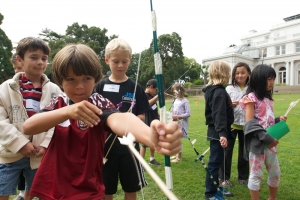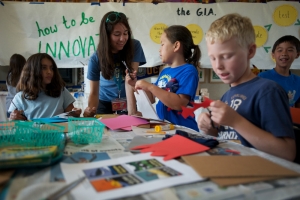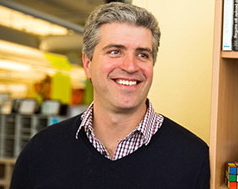Posted on 6/12/2013
Written by Glen Tripp
For many years, everyone from President Obama to CEOs to author Thomas Friedman has been calling for the development of a new generation of innovators. Indeed, our world needs innovators to build our economies, strengthen our democracies, solve big problems and pursue new opportunities.
 And if this call to action is not strong enough to move us, there’s a more personal one: Innovators are happier, because they can apply their innovation skills to improve their own lives. When I act like an innovator, I refuse to merely receive what the world gives me. Instead I imagine what might be possible in my professional life, my family relationships, my pursuit of a passion or my role in my community, and I go out and make that vision a reality. I call this “personal innovation.”
And if this call to action is not strong enough to move us, there’s a more personal one: Innovators are happier, because they can apply their innovation skills to improve their own lives. When I act like an innovator, I refuse to merely receive what the world gives me. Instead I imagine what might be possible in my professional life, my family relationships, my pursuit of a passion or my role in my community, and I go out and make that vision a reality. I call this “personal innovation.”
These two categories of innovation—global and personal—require a similar mindset and process. Innovators are visionary, courageous, collaborative, determined and reflective. Innovators know how to identify a goal, generate ideas, create, test, revise and then share their work. They don’t let fear stand in the way of trying new things. They don’t give up when things don’t go right at first. They persevere until they’ve achieved their desired outcome. Wouldn’t we all want our kids to grow up with these attributes?
Fortunately, given the right tools and environment, kids can learn how to be innovators. I know, because over the past 12 years I’ve seen 200,000 kids in my innovation camps stretch their innovation muscles and prove to themselves that they have the power to envision and create a better world.
This summer alone, more than 35,000 San Francisco Bay Area kids will attend our Camp Galileo and Galileo Summer Quest programs. Together they will build go-karts, design roller coasters, program computers, paint murals, cook feasts, make films and bring robots to life. And as they tackle these engaging projects, they will be immersed in an environment that teaches and reinforces the innovator’s mindset and process at every step.
Galileo camps draw a wide range of kids—perhaps this is the most encouraging news we can share. We have a 50-50 boy-girl ratio. We have 4 year olds and 14 year olds. We have jocks and geeks, artists and techies, mainstream and special needs kids, studious kids and kids who just want to play. The joy that comes from creating is universal. When you take the spirits of Silicon Valley, San Francisco and the Stanford School of Design, and roll them up into camp, everybody has a good time.
 If we can agree that the world needs innovators, that innovators are happier and that all kinds of kids can become more innovative given the right environment and experiences, what’s the next step? What can a parent do to help? Here are some ideas:
If we can agree that the world needs innovators, that innovators are happier and that all kinds of kids can become more innovative given the right environment and experiences, what’s the next step? What can a parent do to help? Here are some ideas:
-
If you’re deciding what school to attend, go beyond traditional test scores and find one that embraces innovation. You can look for clues in the stated mission and values of the school, the presence of project-based learning and the themes the principal emphasizes in emails or presentations.
-
If you’re already situated in a school, introduce the innovator’s mindset and process at a parent-teacher conference, and ask your teacher for help in reinforcing them with your child. As the year goes on, ask for feedback regarding your child’s willingness to try new things, make mistakes or collaborate.
-
When you are presented with a piece of your child’s school work, or after attending an activity like a soccer game, use conversations to reinforce the innovator’s mindset. Rather than passing judgment on the work (“That’s beautiful!”), ask questions and applaud the determination or vision involved.
-
Help your child pursue his or her passion.
-
Create time and space for creativity. Free up several two-hour blocks per week, and resist the urge to solve the “I’m bored” complaint. Out of boredom can come amazing things. Establish a place in the house that can get messy and is abundant with creative supplies.
-
Don’t default to the standard after school or summer programs. In addition to considering the program’s activities, which is where most people stop, examine the culture of the program and people involved and determine what is being taught beyond the activities. Look for programs that will develop your young innovator.
-
Use family projects, from birthday and vacation planning to hosting a Sunday brunch, to teach your kids the innovator’s process: identify goals, generate ideas, design, create, test, evaluate, redesign, share.
-
Your kids are watching! Be a role model for the innovator’s mindset. Imagine possibilities, bravely try new things, embrace failure as part of progress and persevere through challenges.
It’s time for us all to act in response to the call for innovators. But we can’t just tell kids to be innovative—we need to give them the space to explore their creative instincts, the tools to realize their vision and the confidence to believe that they can change the world.
Glen Tripp is the founder and CEO of Galileo Learning. He is a frequent public speaker and an impassioned champion of innovation education. Since founding Galileo in 2002, he has brought his vision of innovation for all to 200,000 kids and counting at 38 camps in the Bay Area. To learn more about Galileo, visit www.galileo-camps.com.












Leave A Comment
You must be logged in to post a comment.